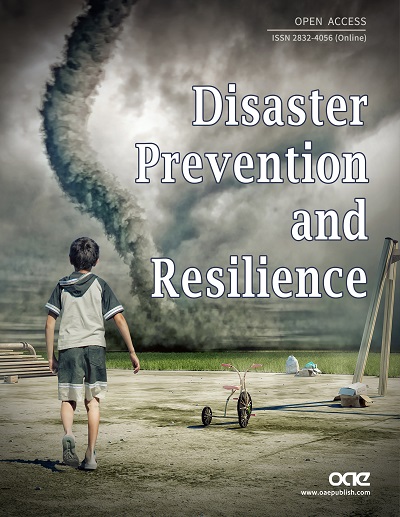REFERENCES
1. Kam WY, Pampanin S, Elwood K. Seismic performance of reinforced concrete buildings in the 22 February Christchurch (Lyttelton) earthquake. Bull NZ Soc Earthq Eng 2011;44:239-78.
2. Pampanin S. Reality-check and renewed challenges in earthquake engineering: implementing low-damage systems - from theory to practice. Bull NZ Soc Earthq Eng 2012;45:137-60.
3. O’reilly GJ, Perrone D, Fox M, Monteiro R, Filiatrault A. Seismic assessment and loss estimation of existing school buildings in Italy. Eng Struct 2018;168:142-62.
4. Sousa L, Monteiro R. Seismic retrofit options for non-structural building partition walls: Impact on loss estimation and cost-benefit analysis. Eng Struct 2018;161:8-27.
5. Bianchi S, Pampanin S. Fragility functions for architectural nonstructural components. J Struct Eng 2022;148:03122005.
6. National Centers for Environmental Information. Monthly global climate report for annual 2021. Available from: https://www.ncei.noaa.gov/access/monitoring/monthly-report/global/202113/supplemental/page-1 [Last accessed on 15 August 2023].
7. Meehl GA, Tebaldi C. More intense, more frequent, and longer lasting heat waves in the 21st century. Science 2004;305:994-7.
8. Crawley DB. Estimating the impacts of climate change and urbanization on building performance. J Build Perform Simul 2008;1:91-115.
9. Sun K, Zhang W, Zeng Z, Levinson R, Wei M, Hong T. Passive cooling designs to improve heat resilience of homes in underserved and vulnerable communities. Energy Build 2021;252:111383.
10. EEA. Economic losses from climate-related extremes in Europe. Copenhagen, Denmark: European Environmental Agency, 2019.
11. Ritchie H, Rosado P, Roser M. Natural disasters. Available from: https://ourworldindata.org/natural-disasters [Last accessed on 15 August 2023].
12. Pohoryles D, Bournas D, Da Porto F, Caprino A, Santarsiero G, Triantafillou T. Integrated seismic and energy retrofitting of existing buildings: A state-of-the-art review. J Build Eng 2022;61:105274.
13. Menna C, Felicioni L, Negro P, et al. Review of methods for the combined assessment of seismic resilience and energy efficiency towards sustainable retrofitting of existing European buildings. Sustain Cities Soc 2022;77:103556.
14. Menna C, Del Vecchio C, Di Ludovico M, Mauro GM, Ascione F, Prota A. Conceptual design of integrated seismic and energy retrofit interventions. J Build Eng 2021;38:102190.
15. Bournas DA. Concurrent seismic and energy retrofitting of RC and masonry building envelopes using inorganic textile-based composites combined with insulation materials: A new concept. Composites Part B Eng 2018;148:166-79.
16. Zanni J, Cademartori S, Marini A, et al. Integrated deep renovation of existing buildings with prefabricated shell exoskeleton. Sustainability 2021;13:11287.
17. Baek E, Pohoryles D, Kallioras S, Bournas D, Choi H, Kim T. Innovative seismic and energy retrofitting of wall envelopes using prefabricated textile-reinforced concrete panels with an embedded capillary tube system. Eng Struct 2022;265:114453.
18. Caruso M, Pinho R, Bianchi F, Cavalieri F, Lemmo MT. Integrated economic and environmental building classification and optimal seismic vulnerability/energy efficiency retrofitting. Bull Earthq Eng 2021;19:3627-70.
19. Calvi GM, Sousa L, Ruggeri C. Energy efficiency and seismic resilience: a common approach. In: Multi-hazard approaches to civil infrastructure engineering. Berlin: Springer; 2016. pp. 165-208.
20. Pohoryles D, Maduta C, Bournas D, Kouris L. Energy performance of existing residential buildings in Europe: A novel approach combining energy with seismic retrofitting. Energy Build 2020;223:110024.
21. Marini A, Passoni C, Belleri A, et al. Combining seismic retrofit with energy refurbishment for the sustainable renovation of RC buildings: a proof of concept. Eur J Environ Civ Eng 2022;26:2475-95.
22. Bruneau M, Chang SE, Eguchi RT, et al. A framework to quantitatively assess and enhance the seismic resilience of communities. Earthq Spectra 2003;19:733-52.
23. Almufti I, Willford M. REDi Rating system resilience-based earthquake design initiative for the next generation of buildings. Arup, San Francisco, United States, 2013.
24. FEMA. Recommended options for improving the built environment for post-earthquake reoccupancy and functional recovery time, FEMA P-2090/ NIST SP-1254. Washington, United States, 2021.
25. Marasco S, Kammouh O, Cimellaro GP. Disaster resilience quantification of communities: a risk-based approach. Int J Disaster Risk Reduct 2022;70:102778.
26. Samadian D, Ghafory-ashtiany M, Naderpour H, Eghbali M. Seismic resilience evaluation based on vulnerability curves for existing and retrofitted typical RC school buildings. Soil Dyn Earthq Eng 2019;127:105844.
27. Hu J, Wen W, Zhai C, Pei S, Ji D. Seismic resilience assessment of buildings considering the effects of mainshock and multiple aftershocks. J Build Eng 2023;68:106110.
28. Rodrigues L, Gillott M. Building for future climate resilience. In: Hakansson A, Höjer M, Howlett R, Jain L, eds. Sustainability in energy and buildings. smart innovation, systems and technologies. Berlin: Springer; 2013. pp. 453-62.
29. Zeng Z, Zhang W, Sun K, Wei M, Hong T. Investigation of pre-cooling as a recommended measure to improve residential buildings’ thermal resilience during heat waves. Build Environ 2022;210:108694.
30. O’Donovan A, Murphy MD, O’sullivan PD. Passive control strategies for cooling a non-residential nearly zero energy office: simulated comfort resilience now and in the future. Energy Build 2021;231:110607.
31. Sharifi A, Pathak M, Joshi C, He B. A systematic review of the health co-benefits of urban climate change adaptation. Sustain Cities Soc 2021;74:103190.
32. Homaei S, Hamdy M. Thermal resilient buildings: how to be quantified? A novel benchmarking framework and labelling metric. Build Environ 2021;201:108022.
33. Pongiglione M, Calderini C. Sustainable structural design: comprehensive literature review. J Struct Eng 2016;142:04016139.
34. Moehle J, Deierlein G. A framework methodology for performance-based earthquake engineering. In Proceedings of the 13th World Conference on Earthquake Engineering; 1-6 August 2003; Vancouver, United States.
35. Porter KA. An overview of PEER’s performance-based earthquake engineering methodology. In Proceedings of the 9th International Conference on Applications of Statistics and Probability in Civil Engineering; 6-9 July 2003; San Francisco, United States.
36. FEMA. Seismic performance assessment of buildings, volume 1 - methodology. technical report FEMA-P-58-1. Washington, USA: Federal Emergency Management Agency; 2018.
37. Bianchi S, Ciurlanti J, Overend M, Pampanin S. A probabilistic-based framework for the integrated assessment of seismic and energy economic losses of buildings. Eng Struct 2022;269:114852.
38. Jin Q, Overend M. A prototype whole-life value optimization tool for façade design. J Build Perform Simul 2014;7:217-32.
39. Montali J, Sauchelli M, Jin Q, Overend M. Knowledge-rich optimisation of prefabricated façades to support conceptual design. Autom Costr 2019;97:192-204.
40. Bianchi S, Ciurlanti J, Pampanin S. Comparison of traditional vs low-damage structural and non-structural building systems through a cost/performance-based evaluation. Earthq Spectra 2021;37:366-85.
41. Klein T. Integral facade construction - towards a new product architecture for curtain walls. Delft: Delft University of Technology; 2013.
42. Arup. Net-zero buildings Where do we stand? Technical report, 2021. Available from: https://globalabc.org/sites/default/files/2021-07/Net_zero_buildings_where_do_we_stand.pdf [Last accessed on 16 August 2023].
43. Baird A, Palermo A, Pampanin S. Façade damage assessment of concrete buildings in the 2011 Christchurch earthquake. Struct Concrete 2012;13:3-13.
44. Kelly JM, Skinner RI, Heine AJ. Mechanisms of energy absorption in special devices for use in earthquake resistant structures. Bull NZ Soc Earthq Eng 1972;5:63-88.
45. NTC. Aggiornamento delle Norme Tecniche per le Costruzioni, Supplemento ordinario n°8 alle G.U. n° 42 del 20/02/2018. Rome, Italy, 2018. Available from: https://www.gazzettaufficiale.it/eli/gu/2018/02/20/42/so/8/sg/pdf [Last accessed on 16 August 2023].
46. Priestley NMJ, Calvi GM, Kowalsky MJ. Direct displacement-based seismic design of structures. Pavia: IUSS Press; 2007.
47. Pampanin S, Marriott D, Palermo A, New Zealand concrete society. PRESSS design handbook. Auckland: New Zealand Concrete Society; 2010.
48. Ciurlanti J, Bianchi S, Pampanin S. Raising the bar in seismic design: cost-benefit analysis of alternative design methodologies and earthquake-resistant technologies. Bull Earthq Eng 2023;21:2723-57.
49. Carr Athol J. Ruaumoko program for inelastic dynamic analysis - user manual. Christchurch: University of Canterbury; 2003.
50. Zendaoui A, Kadid A, Yahiaoui D. Comparison of different numerical models of RC elements for predicting the seismic performance of structures. Int J Concr Struct Mater 2016;10:461-78.
51. Carvalho G, Bento R, Bhatt C. Nonlinear static and dynamic analyses of reinforced concrete buildings - comparison of different modelling approaches. Earthq Struct 2013;4:451-70.
52. Magenes G, Pampanin S. Seismic response of gravity-load design frames with masonry infills. In Proceedings of the 13th World Conference on Earthquake Engineering; 1-6 August 2003; Vancouver, United States.
53. Bertoldi SH, Decanini LD, Gavarini C. Telai tamponati soggetti ad azione sismica, un modello semplificato: confronto sperimentale e numeric. In Proceedings of the 6th Convegno Nazionale ANIDIS; 13-15 October 1993; Perugia, Italy.
54. Crisafulli FJ. Seismic behaviour of reinforced concrete structures with masonry infills. PhD Thesis, Christchurch: University of Canterbury, 1997.
55. Bianchi S, Ciurlanti J, Pampanin S. A SLaMA-based analytical procedure for the cost/performance-based evaluation of buildings. In Proceedings of the 7th International Conference on Computational Methods in Structural Dynamics and Earthquake Engineering; 24-26 June 2019; Crete, Greece.
56. Freeman SA. Review of the development of the capacity spectrum method. ISET J Earthq Technol 2004;41:1-13. Available from: https://engineering.purdue.edu/~ce573/Documents/SAF_Review%20of%20Capacity%20Spectrum%20Method.pdf [Last accessed on 16 August 2023]
57. Cardone D, Perrone G. Developing fragility curves and loss functions for masonry infill walls. Earthq Struct 2015;9:257-79.
58. Tasligedik AS, Pampanin S. Rocking cantilever clay brick infill wall panels: a novel low damage infill wall system. J Earthq Eng 2017;21:1023-49.
59. Bianchi S, Ciurlanti J, Perrone D, et al. Shake-table tests of innovative drift sensitive nonstructural elements in a low-damage structural system. Earthquake Engng Struct Dyn 2021;50:2398-420.
60. Simonen K, Huang M, Aicher C, Morris P. Embodied carbon as a proxy for the environmental impact of earthquake damage repair. Energy Build 2018;164:131-9.
61. Basic S, Hollberg A, Galimshina A, Habert G. A design integrated parametric tool for real-time life cycle assessment - bombyx project. IOP Conf Ser Earth Environ Sci 2019;323:012112.
62. Ministero delle Infrastrutture. Linee guida per la classificazione del rischio sismico delle costruzioni, Allegato A. Decreto Ministeriale 65 of 07/03/2017, Rome, Italy, 2017. Available from: https://www.logical.it/pdf/sismabonus/DM_65_del_07-03-2017_All_A.pdf [Last accessed on 16 August 2023].
63. Ministero dello Sviluppo Economico. Linee guida nazionali per la certificazione energetica degli edifici, Allegato 1. Decreto interministeriale 26 Giugno 2015, Rome, Italy, 2015. Available from: https://www.mimit.gov.it/images/stories/normativa/DM_Linee_guida_APE_allegato1.pdf [Last accessed on 16 August 2023].
64. LETI. Embodied carbon target alignment. London Energy Transformation Initiative, 2020. Available from: https://www.leti.uk/_files/ugd/252d09_25fc266f7fe44a24b55cce95a92a3878.pdf [Last accessed on 16 August 2023].
65. Saaty TL. The analytic hierarchy process. New York: McGraw-Hill; 1980. p. 287.






